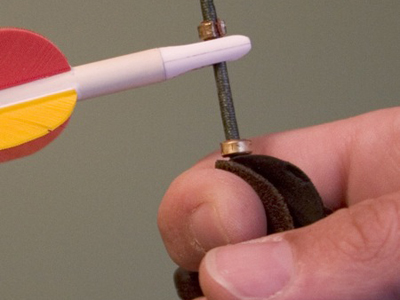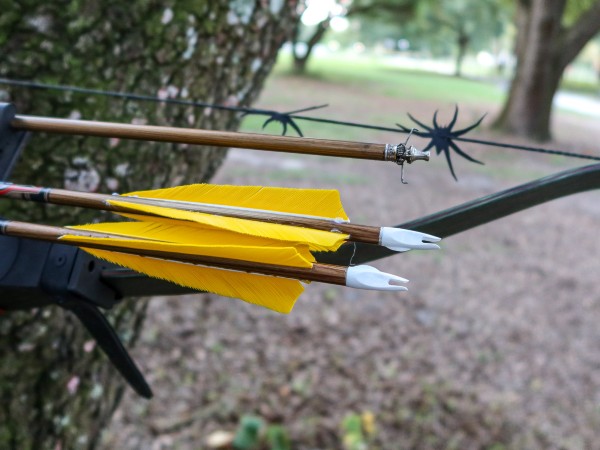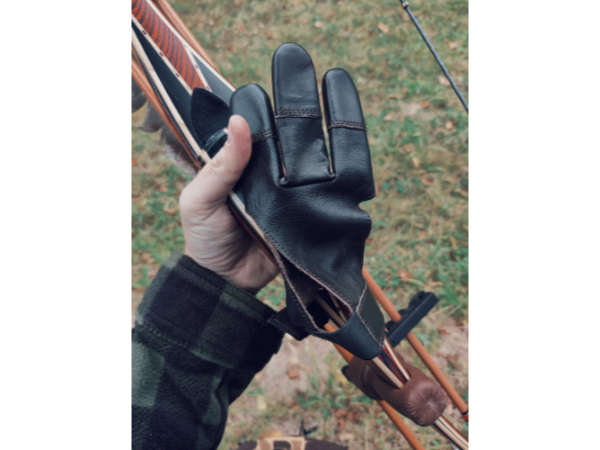One of the best things about barebow shooting is its diversity. There is no one “correct” way to do it. Spend a day at most traditional shoots and you’ll see people differing in how they hold the string, hold their bows, draw, anchor, and aim. Over the past 26 years I’ve tried countless different barebow shooting and aiming methods. String-walking is just one.
String-walking is simply the act of sliding (or “walking”) your fingers down the bowstring a predetermined distance below the arrow nock depending on the yardage of the shot. The amount of distance between the arrow nock and your fingers is sometimes referred to as the “crawl.” The closer the shot, the more the crawl distance. Essentially what you are doing is raising and lowering the rear of the arrow so that you are always aiming “point-on,” no matter the shot distance.
Tabs such as those made by Black Widow are popular among string-walkers, who use the stitches as a reference for different crawls. Although string-walking can create tuning issues and prove too cumbersome for many people in bowhunting situations, there is a simple way to utilize this shooting method for the hunting woods.
Back when I used to walk the string for bowhunting, I tuned my bow for my 20-yard crawl. I then secured a second nock point at that location so that I could get my hand on the string properly without taking my eyes off the animal. For minor distances variations closer or further than 20 yards, I simply aimed slightly lower or higher.
This is somewhat of a hybrid system between string-walking and gap shooting, but it eliminates some of the potential pitfalls of pure string-walking in bowhunting situations. Your tuning and finger placement never changes, and you simply draw, point, and shoot. If you’re looking to change your shooting method, you may want to give this system a try.







Joe sent me the following comment:
I don’t see where to put the comments so I will just reply. On the string walking article. I would suggest using 2 nock points, one at top and one at bottom bottom of the arrow to prevent it from sliding down upon release. The string is at a sharp angle and the nock will slide down differently on every shot , which will really mess up your groups and it isn’t obvious what is happening.
Great magazine and also great tips!
Saw the video on The Push last year and converted to shooting a fixed crawl. Improvement was dramatic. Good tip.
I crawl up and down the string for target/3D shooting. For hunting a fixed crawl works best for me, tough to draw and redraw to relocate the tab as the deer walks toward or away from me. With a 20-25yd fixed crawl hold over or under is minimal. A tied-on nock to locate the fixed crawl works fine.
Definitely recommend “The Push.”
Call me an idiot, but I stumbled on to this method before I ever knew it was a “thing”.
I was quickly discovering the “cumbersome” nature of string walking and settled in on this technique without even knowing it had a name.
A few years later, I too saw “The Push”. Despite discovering I had not discovered anything, and reaffirming Solomon’s wisdom on the subject of “nothing is new”, I stuck with it, and it has served me well.
Especially with a tied-on nock, you can also revert back, and walk over your nock point for longer shots at targets.
I guess it came naturally. Even when I shoot “instinctively”‘ I still judge range as a separate process. I practice almost entirely at 20 yards. When an animal is closer, I simply “focus” lower.
Great tip to add to your options.